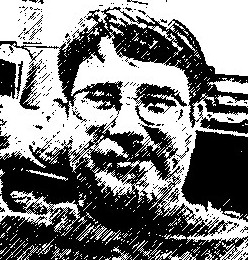...but it works...finally. Sort of.
When last I posted, I had
used my new Fast Tracks Code 40 N/Nn3 jig to build a dual gauge right
turnout with rails to the left. It took a while but I finally got the
physical turnout built. The electrical isolation will come later. I had a
few issues during the build, compounded by the fact that there really
aren't any instructions with the jig.
The
instructions, such as they are, that are available are for HO dual
gauge turnouts. They basically just list the order in which the rails go
in. Since the N/Nn3 dual gauge fixture uses a slightly different rail
arrangement from the HO/HOn3 fixture these are of limited use. The first problem I had was with the check rails between the standard and narrow gauge, there just isn't enough room to reach in there with my soldering iron. What I
finally decided to do was remove the standard
gauge stock rail on the dual rail side first in order to put them in, but
the NEXT time they will go in immediately after their adjacent stock rails.
The second major issue I had was connecting the points rail for the standard
gauge rail on the double rail side. There just isn't a lot of room to
play with there and I kept soldering the rails together. I finally
solved the problem by wrapping paper around the stock rails to isolate
them. Then I put a spacer under the throwbar so I could hold the points
rails down onto it and get the solder to stick. The paper kept the
solder from sticking on to the stock rails while allowing the solder to
flow from the points rails to the throwbar. Having a more delicate
soldering iron for this definitely would have helped, but I have what I
have. Perhaps I can find one with a smaller point in the future that
would be better for this job. I considered removing the standard gauge
stock rail again to do this, but decided against it because the points
rails on the dual gauge side have to be synchronized. For my next attempt I will put the points rails in immediately after their stock rails are installed and solder them to the throwbar at that time; both standard gauge points first and then the inside narrow gauge point rail and stock rail.
The
next issue I had was adjusting the gauge here and there to clear
flanges and whatnot when testing with MicroTrains standard and narrow
gauge trucks. I had to move some stock and check rails out to increase
the clearances, and file some of the rails at the frogs (that's a tricky
little bit there, too much and the wheels drop into the gaps, too
little and they won't go through the check rails). This took a while to
do, but both of the trucks will now go through the frogs without (much)
issue. Next time I will take a bit more time working with the file to try to create a more precise fit.
I
was concerned that the standard gauge trucks with the "pizza cutter" wheels would hit the ties, as
happens with Atlas code 55 track. I am pleasantly surprised to see that
doesn't happen, but I haven't put the turnout into actual service yet so
I haven't run any locos through it. I am assuming that newer
locomotives won't have too many issues but I'm not so sure about some of
my older ones. I have checked some of their wheel flanges with a
micrometer and I am somewhat surprised to learn that most of them
measure around 0.035", so as long as my solder joints are not horribly
large they may just run OK.
But,
before I can do that I will have to cut the isolation gaps. Once again,
lacking clear instructions, this will take some looking and planning to
see where to make the cuts. I think I have it figured out...but
something I also figured out is that the saw I have used to do this on
my code 55 Nn3 turnouts is just not adequate for the job. So, I have the
appropriate saw on order and it should be here soon. In the meantime
I'm working the turnout over with some jeweler's files to clean up
errant pieces of solder and smoothing some of the transitions in the
frogs and check rails.
At first I
was a bit sad that the jig wasn't made for code 55 to match Peco
flextrack, but I did understand that the clearances just weren't
adequate for the check rails using code 55 rail. Now that I've actually
built the turnout that understanding has been massively reinforced. I
can either join it up to code 55 or hand lay code 40 track when I
finally build the yard where they will be used, but that will be a while
yet.
I
am sure that the next turnouts will go easier, but I am initially
satisfied with this one. When the turnout is complete I will mount it up
and try running some locos through it under power. I'll let you know
how that goes when it happens.
In other news, as of today I am eligible for senior's discounts. So I have that going for me...

No comments:
Post a Comment